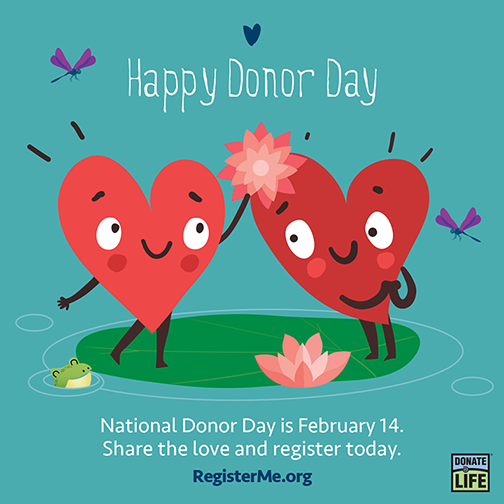February 14th is not only Valentine’s Day but also National Donor Day, recognized since 1998 to raise awareness of the critical importance of organ, eye, tissue, marrow, and blood product donation. The day also serves as a reminder of the nearly 120,000 individuals who are on the national organ transplant waiting list.
National Donor Day is a time to focus on all types of donation – organ, eye, tissue, blood, platelets and marrow – by participating in blood/marrow drives or donor registration events. It is also a day to appreciate donors and loved ones who have given the gift of life, have received a donation, are currently waiting or did not receive an organ in time.
Donate Life America launched the National Donate Life Living Donor Registry in 2022, a national-reaching living donor registry with the goal of reducing access barriers for prospective living donors. Individuals between the ages of 18-65 who register their decision to be a deceased organ, eye and tissue donor through the National Donate Life Registry, RegisterMe.org, will also be offered the opportunity to register their interest in being a living kidney donor.
A living donor is an option for patients who otherwise may face a lengthy wait for an organ from a deceased donor. To spare an individual a long and uncertain wait, relatives, loved ones, friends, and even individuals who wish to remain anonymous may serve as living donors. Kidney and liver transplant candidates who are able to receive a living donor transplant can receive the best quality organ much sooner, often in less than a year.
- More than 100,000 people are on the national transplant waiting list.
- More than 85% of patients waiting are in need of a kidney.
- 11% of patients waiting are in need of a liver.
In 2021, 6,500 living donor transplants were performed thanks to the generosity of living donors.
- Living donation is an opportunity to save a life while you are still alive.
- Living organ donation and transplantation was developed as a direct result of the critical shortage of deceased donors.
- Living donors don’t have to be related to their recipients. On average, 1 in 4 living donors are not biologically related to the recipient.
- Patients who receive a living donor transplant are removed from the national transplant waiting list, making the gift of a deceased donor kidney or liver available for someone else in need.
- If you are considering being a living donor, it’s important to note that living donation is not included in your deceased donor registration. In the coming years, you will be able to register your interest in being a living donor in the National Donate Life Living Donor Registry (check back for updated information). In the meantime, visit DonateLife.net/how-to-start-the-living-donation-process/ for more information on how to start the process.


Leave A Comment